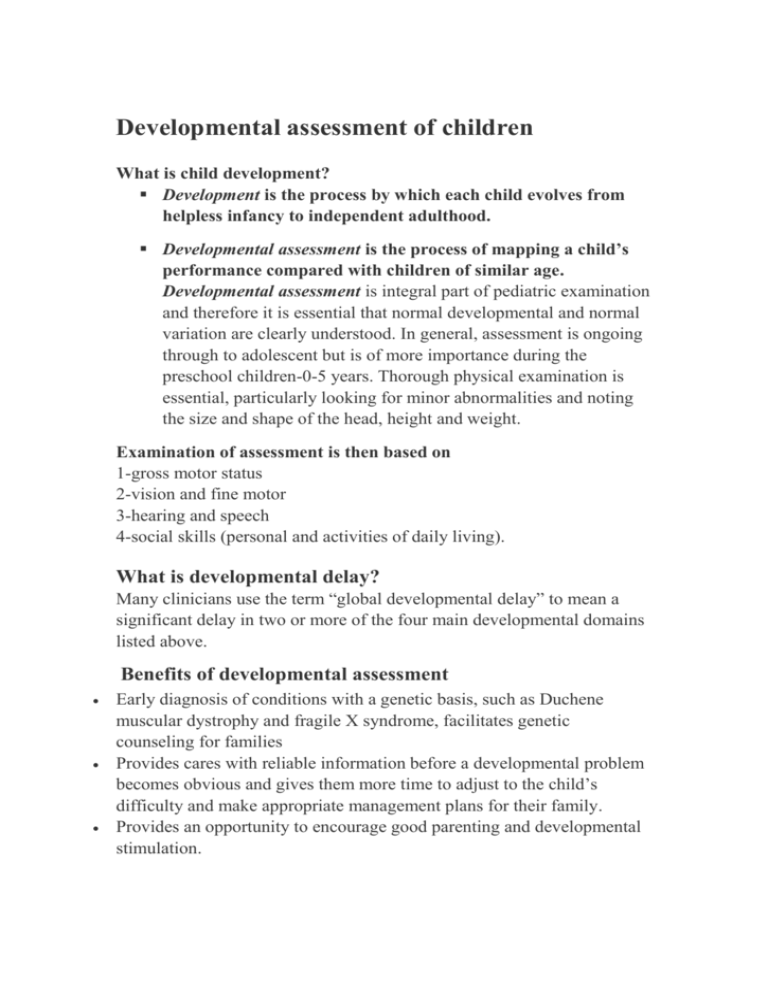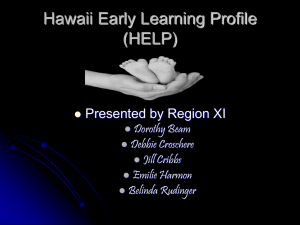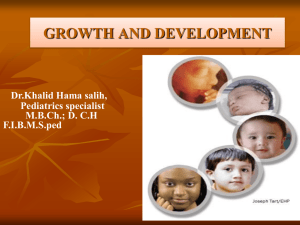pubdoc_12_2146_938
advertisement

Developmental assessment of children What is child development? Development is the process by which each child evolves from helpless infancy to independent adulthood. Developmental assessment is the process of mapping a child’s performance compared with children of similar age. Developmental assessment is integral part of pediatric examination and therefore it is essential that normal developmental and normal variation are clearly understood. In general, assessment is ongoing through to adolescent but is of more importance during the preschool children-0-5 years. Thorough physical examination is essential, particularly looking for minor abnormalities and noting the size and shape of the head, height and weight. Examination of assessment is then based on 1-gross motor status 2-vision and fine motor 3-hearing and speech 4-social skills (personal and activities of daily living). What is developmental delay? Many clinicians use the term “global developmental delay” to mean a significant delay in two or more of the four main developmental domains listed above. Benefits of developmental assessment Early diagnosis of conditions with a genetic basis, such as Duchene muscular dystrophy and fragile X syndrome, facilitates genetic counseling for families Provides cares with reliable information before a developmental problem becomes obvious and gives them more time to adjust to the child’s difficulty and make appropriate management plans for their family. Provides an opportunity to encourage good parenting and developmental stimulation. Neonatal Period (1st 4 Wk( Grosse motor: Lies in flexed attitude; turns head from side to side ; head sags on ventral suspension. Generally flexed and a little stiff. Visual, and fine motor: May fixate face or light in line of vision; “doll's-eye&” delay movement of eyes on turning of the body Reflex: Moro response active; stepping and placing reflexes; grasp reflex active. Social: Visual preference for human face. 4-8 week Grosse motor: Legs more extended; holds chin up; turns head; head lifted momentarily to plane of body on ventral suspension. Head lags on pull to sitting position Visual, fine motor: Watches person; follows moving in 90 degree object Social: listens to voice and coos, beginning to smile 3months Gross motor =ventral suspension head is held up for prolonged period, can hold shoulders off table when in prone position. Sitting: head lag partially compensated when pulled to sitting position. Vision and fine motor =appears alert and open the hands spontaneously and grasp reflex is gone. Follows moving object in 180 degree. Hearing and speech = more responsive to noise and may turn to sound, coos and laughs Social skills = smiles appropriately 6-8months Gross motor =sits momentarily, good head control, rolls over, back straight. Fine motor and vision =transfers objects, alert, eyes move in all directions, fixates on small objects-20 cm Hearing and speech =babbling, turns to sounds 0.5m, vocalize-Ka, dah. Social skills =shows like and dislikes, mouthing, tries to hold bottle, response to tickling. Warnings Poor head control Brisk reflexes and clonus Not alert Not Turing to sounds Persistent primitive reflexes. 9-10months Gross motors=pull to stand, sits alone and can turn to look (pivoting), crawling, does not like being moved from sitting to lying supine Fine motor and vision =pincer grasp, can see small objects at 3m Hearing and speech =imitate sounds, test hearing at 1 m(distraction test). Social skills =hold, bites, chews biscuit, can wave bye , beginning of suspicion of strangers. Warnings Not sitting Asymmetry of tone Poor response to sounds 12 months Gross motors =walk with one hand held. Fine motor =release an object on command Hearing and speech =1-2 meaningful words Social skills =come when called, casting object, mouthing stop. 15 month Gross motor =walk alone, crawled upstairs and unable to get down. Vision and fine motor =Makes tower of 3 cubes, makes a line. Hearing and speech= jargon, flow simple command Social skills = may names of some familiar object (ball). Indicates some desires or needs by pointing, hug parent. 18 months Gross motors =walks upstairs with assistance and creep down, run stiffly, sit on small chair. Fine motor =feeds from spoon without falling, point to distant objects, Makes tower of 4 cubes; imitates scribbling; imitates vertical stroke; Hearing and speech =at least 10 words, vocalize freely, responds quickly to simple commands, name picture, identify one or more parts of body. Social skills =mimic the actions of others (domestic mimicry), stopped putting toys into mouth, kiss parent, complain when wet, seek help in trouble. Warning Not standing Not walking Poor attention span 24 months Gross motors =runs well, climb on furniture , jump, goes up and down stairs two feet/step , kicks a ball without falling. Fine motor =builds tower of 7blocks, imitate horizontal line, Hearing and speech =2-3 word sentences, put 3 words together (subject, verb, object) Social skills =plays with others, help to undress, hold spoon well. 3YEARS Gross motors= Can walk upstairs, one foot per step, able to jump, stands on one foot momentarily ,may able to ride tricycle Fine motor: Builds tower of10 blocks, draw a circle, imitates cross. Hearing and speech = may know one to two colors, count to 10,know age ,sex, and full name Social skills =play simple games in parallel with others children, wash hand. 4years Gross motors= Hop on one foot, can walk downstairs in adult fashion, climb well. Fine motor = draw square and Cross, draw man with 2-4 part of body beside the head, with left or right hand dominant. Hearing and speech = know 3-4 colors, Talks a lot, asks question-tell stories Social skills =toilet training well established, play with several children with interaction. Note: The rate of development may vary between children, the sequence of development does not differ significantly 5year Gross motors= skipping, walk heel to toe. Fine motor =draw triangle, name heavier of 2 weight. Hearing and speech =5 colors, repeat sentence of 10 syllables Social skills = dress and undress Developmental decision Normal Probably normal-see again Doubtful-see soon Abnormal-refer for diagnosis and treatment Locomotion variants: some infant never crawl ,they stand and walk Some do normal crawl with flexed knees Some do bear walk knees extended) Some commando crawl-on elbows rather than hands







